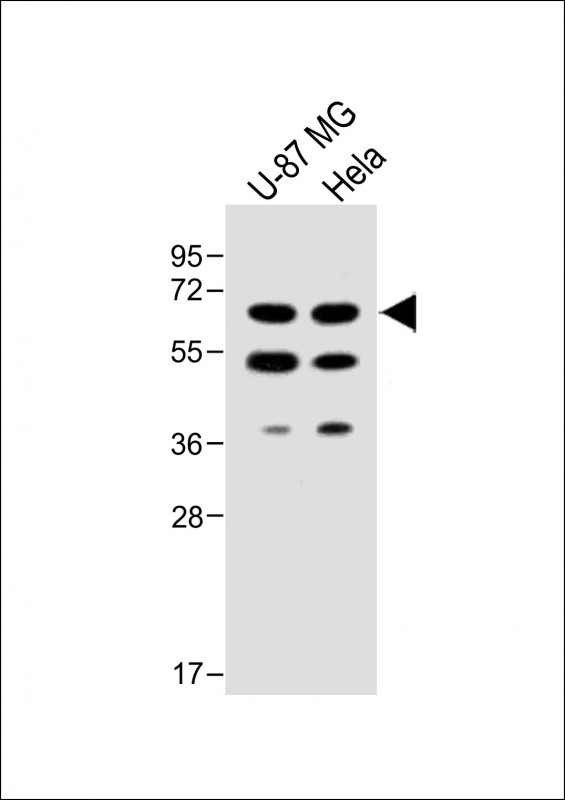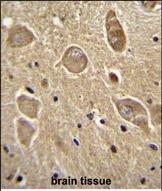UGT8 antibody (Center)
Affinity Purified Rabbit Polyclonal Antibody (Pab)
- SPECIFICATION
- CITATIONS: 1
- PROTOCOLS
- BACKGROUND

Application
| WB, IHC-P, E |
|---|---|
| Primary Accession | Q16880 |
| Other Accession | Q09426, Q64676, NP_001121646.1, NP_003351.2 |
| Reactivity | Human, Mouse |
| Predicted | Rat |
| Host | Rabbit |
| Clonality | Polyclonal |
| Isotype | Rabbit IgG |
| Calculated MW | 61438 Da |
| Antigen Region | 366-393 aa |
| Gene ID | 7368 |
|---|---|
| Other Names | 2-hydroxyacylsphingosine 1-beta-galactosyltransferase, Ceramide UDP-galactosyltransferase, Cerebroside synthase, UDP-galactose-ceramide galactosyltransferase, UGT8, CGT, UGT4 |
| Target/Specificity | This UGT8 antibody is generated from rabbits immunized with a KLH conjugated synthetic peptide between 366-393 amino acids from the Central region of human UGT8. |
| Dilution | WB~~1:1000 IHC-P~~1:10~50 E~~Use at an assay dependent concentration. |
| Format | Purified polyclonal antibody supplied in PBS with 0.09% (W/V) sodium azide. This antibody is purified through a protein A column, followed by peptide affinity purification. |
| Storage | Maintain refrigerated at 2-8°C for up to 2 weeks. For long term storage store at -20°C in small aliquots to prevent freeze-thaw cycles. |
| Precautions | UGT8 antibody (Center) is for research use only and not for use in diagnostic or therapeutic procedures. |
| Name | UGT8 (HGNC:12555) |
|---|---|
| Synonyms | CGT, UGT4 |
| Function | Catalyzes the transfer of galactose to ceramide, a key enzymatic step in the biosynthesis of galactocerebrosides, which are abundant sphingolipids of the myelin membrane of the central nervous system and peripheral nervous system (PubMed:9125199). Galactosylates both hydroxy- and non-hydroxy fatty acid-containing ceramides and diglycerides (By similarity). |
| Cellular Location | Membrane; Single-pass membrane protein. Endoplasmic reticulum {ECO:0000250|UniProtKB:Q09426} |

Provided below are standard protocols that you may find useful for product applications.
Background
Galactocerebrosides are abundant sphingolipids of the myelin membrane of the central nervous system and peripheral nervous system and are also present in small amounts in kidney. The key enzymatic step in the biosynthesis of galactocerebrosides consists of the transfer of galactose to ceramide catalyzed by UDP-galactose ceramide galactosyltransferase (CGT, EC 2.4.1.45). The enzyme encoded by the CGT gene is the first involved in complex lipid biosynthesis in the myelinating oligodendrocyte.[supplied by OMIM].
References
Dziecedil Giel, P., et al. Br. J. Cancer 103(4):524-531(2010)
Kalsi, G., et al. Hum. Mol. Genet. 19(12):2497-2506(2010)
Ross, C.J., et al. Nat. Genet. 41(12):1345-1349(2009)
Ruckhaberle, E., et al. J. Cancer Res. Clin. Oncol. 135(8):1005-1013(2009)
Saito, A., et al. J. Hum. Genet. 54(6):317-323(2009)
If you have used an Abcepta product and would like to share how it has performed, please click on the "Submit Review" button and provide the requested information. Our staff will examine and post your review and contact you if needed.
If you have any additional inquiries please email technical services at tech@abcepta.com.














 Foundational characteristics of cancer include proliferation, angiogenesis, migration, evasion of apoptosis, and cellular immortality. Find key markers for these cellular processes and antibodies to detect them.
Foundational characteristics of cancer include proliferation, angiogenesis, migration, evasion of apoptosis, and cellular immortality. Find key markers for these cellular processes and antibodies to detect them. The SUMOplot™ Analysis Program predicts and scores sumoylation sites in your protein. SUMOylation is a post-translational modification involved in various cellular processes, such as nuclear-cytosolic transport, transcriptional regulation, apoptosis, protein stability, response to stress, and progression through the cell cycle.
The SUMOplot™ Analysis Program predicts and scores sumoylation sites in your protein. SUMOylation is a post-translational modification involved in various cellular processes, such as nuclear-cytosolic transport, transcriptional regulation, apoptosis, protein stability, response to stress, and progression through the cell cycle. The Autophagy Receptor Motif Plotter predicts and scores autophagy receptor binding sites in your protein. Identifying proteins connected to this pathway is critical to understanding the role of autophagy in physiological as well as pathological processes such as development, differentiation, neurodegenerative diseases, stress, infection, and cancer.
The Autophagy Receptor Motif Plotter predicts and scores autophagy receptor binding sites in your protein. Identifying proteins connected to this pathway is critical to understanding the role of autophagy in physiological as well as pathological processes such as development, differentiation, neurodegenerative diseases, stress, infection, and cancer.



